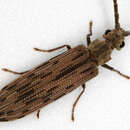en
names in breadcrumbs


The Cupedidae are a small family of beetles, notable for the square pattern of "windows" on their elytra (hard forewings), which give the family their common name of reticulated beetles.[1]
The family consists of about 30 species in 9 genera, with a worldwide distribution. Many more extinct species are known, dating as far back as the Triassic.[1] The family Ommatidae is considered a subfamily of Cupedidae by some authors, but ommatids have been found to more closely related to Micromalthidae in genomic analysis studies.[2]
These beetles tend to be elongated with a parallel-sided body, ranging in length from 10 to 20 mm (0.39 to 0.79 in), with colors brownish, blackish, or gray. The larvae are wood-borers, typically living in fungus-infested wood, and sometimes found in wood construction.[1] The larvae eat the fungus-infested dead wood or tree roots while the adults are believed to subsist on pollen and plant sap.[3]
Males of Priacma serrata (western North America) are notable for being strongly attracted to common household bleach. This suggests that compounds in bleach may resemble attractive compounds found by the beetle in nature.[1]
After Kirejtshuk, Nel & Kirejtshuk, 2016.[4]
The Cupedidae are a small family of beetles, notable for the square pattern of "windows" on their elytra (hard forewings), which give the family their common name of reticulated beetles.
The family consists of about 30 species in 9 genera, with a worldwide distribution. Many more extinct species are known, dating as far back as the Triassic. The family Ommatidae is considered a subfamily of Cupedidae by some authors, but ommatids have been found to more closely related to Micromalthidae in genomic analysis studies.
These beetles tend to be elongated with a parallel-sided body, ranging in length from 10 to 20 mm (0.39 to 0.79 in), with colors brownish, blackish, or gray. The larvae are wood-borers, typically living in fungus-infested wood, and sometimes found in wood construction. The larvae eat the fungus-infested dead wood or tree roots while the adults are believed to subsist on pollen and plant sap.
Males of Priacma serrata (western North America) are notable for being strongly attracted to common household bleach. This suggests that compounds in bleach may resemble attractive compounds found by the beetle in nature.